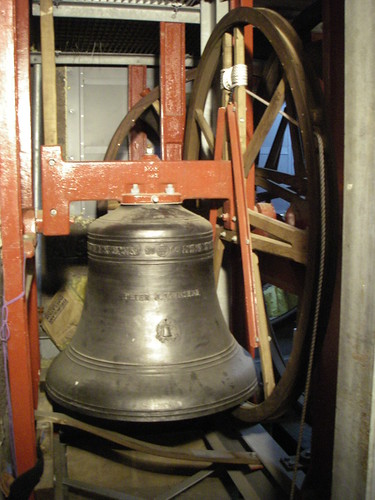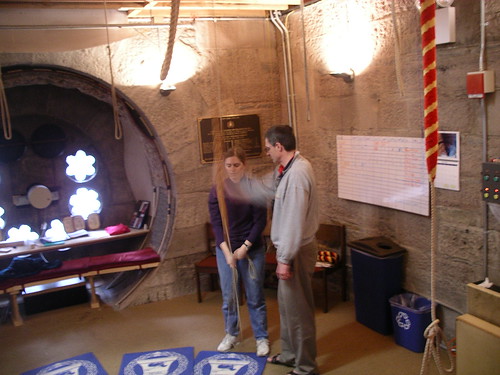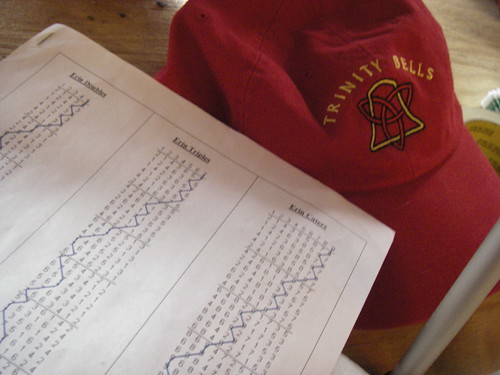So where was I? Oh yes. Campanologma, the dogma of campanologists! Or to put it in plain English, tower bell ringers. My parents began doing "change ringing" during my dad's last Naval assignment. He was stationed in London, and they were living in a village on the outskirts of London. The town had a church with a belltower. The belltower had a band of ringers, many of whom also rang in the church's handbell choir. My mom loves handbells, and pretty much everywhere she's lived since I was in junior high school or so, she's found a choir. I remember it going back to jr. high because she had me doing it for a while - in the end I think the sort of open-ended, we-have-to-do-this-every-Wednesday commitment wore thin on teenaged me. Come to think of it, I still shy away from that sort of commitment when it comes to recreational activities, nothing's really changed - now I just know better than to sign up for that sort of gig in the first place, that way I don't let anybody down in the end.
But I guess I digress. Back to that village in Middlesex - my mom joined that church's handbell choir, as was usual. Where things got unusual was that, as I said, this church also had a set of tower bells - something my folks had never run across before, tower bells not being terribly common in the States (there are 51 active towers in the US and Canada today, and I can personally name 2 - Trinity Church and St. Andrew's in Honolulu - that didn't have sets of tower bells when my folks were in London, and I know that there are more that have been added since then too). The handbell ringers who were also in the tower ringers' band quickly introduced my mom to those, and before too long my dad had joined them too (tower bell music seems to be well-suited to mathematical minds like my dad's - or vice versa - more on that shortly). They both got completely hooked. Much to their delight, that tower in Hawaii was getting bells just as they returned there, and aside from a hiatus when the tower was found to need reinforcement, they were able to continue practically without interruption.
People frequently seem puzzled when I start talking about these "tower bells" that my parents ring. They tend to either picture the sort of single bell hanging in a steeple that churches all over the country use to call congregations to worship (hardly something that would lead people to fly from North Carolina to New York City for a weekend, even if Alexander Hamilton is buried in the churchyard) or they picture something like they have at Riverside Church, where full hymns and carols are played. That instrument is a carillon, and those are played by a single individual, called a "carillonneur", who uses a set of manual controls that can look a lot like an oversized piano keyboard:
 (image from http://www.wellesley.edu).
(image from http://www.wellesley.edu).Each key is attached to the clapper of the corresponding bell - the bells don't actually move.
Tower bells, on the other hand, ring while swinging - and not just in the small, side-to-side arc followed by the steeple-hung bells I was just describing, either. Tower bells are mounted on a sturdy wooden frame shaped like a wheel.
Here are a couple of the bells in the 12-bell ring at Trinity:
 That picture is not upside down - that's the position that bells are put in when they're ready to be rung.
That picture is not upside down - that's the position that bells are put in when they're ready to be rung.Here's one of a couple that were "rung down" for safety, being close to the hatch that gives access to the bells from the ringers' room below:
 This one being smaller, and unobscured by the sturdy girders that brace the tower, I think you can see the whole mechanism. When ringing, the bell starts in the mouth-up "stand" position. Once the ringer pulls the rope to begin ringing, the bell swings through a full 360 degrees, slowing as it reaches the top of the arc, stopping for an instant and then reverses, swinging back the way it came.
This one being smaller, and unobscured by the sturdy girders that brace the tower, I think you can see the whole mechanism. When ringing, the bell starts in the mouth-up "stand" position. Once the ringer pulls the rope to begin ringing, the bell swings through a full 360 degrees, slowing as it reaches the top of the arc, stopping for an instant and then reverses, swinging back the way it came.Did I say "smaller"? It's all relative - here's a little perspective:

That's Greg. He was the organizer of the weekend, and the current leader of the Trinity Ringer. He was the one who gave me a lesson.
Perspective, part 2 - that's me getting my lesson again (photo by my dad). I am five feet, seven inches tall:

So that gives you an idea of the size of these bells. My lesson was on one of the smaller ones. My dad told me later that the one I was using was probably in the five to six hundred pound range. I didn't know exactly what the weight was when I was ringing it, but I knew it felt oddly reminiscent of handling the lines on the big schooner I used to crew on - the force on the other end of the line was simply such that trying to "muscle" it, instead of following it & working with it, would be a really good way to get hurt. My instructions at first were just to follow the line with my hands, trying to keep the rope moving quietly - if you can't do that, you can get a good scare, or possibly even get hurt. I did OK, but first attempts like mine have to be very closely supervised. I was reading a handbook at one point during the ringing, and in the chapter about introducing beginners, there was a warning that nothing scares off a potential ringer like getting yanked off their feet on their first try!
Eventually, once you've got everything more or less in hand, you start to add a little extra "oomph" at the end of each swing of the bell. That keeps the bell going (otherwise it would eventually just ring itself down & stop).
So how do you play music when you can't really "control" your bell in the same way that the carillonneur is able to control each clapper-strike in the carillon?
***************
to be continued!

No comments:
Post a Comment